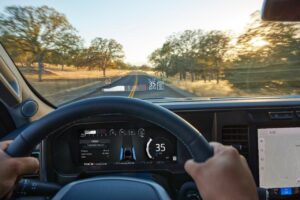
IIHS finds AEB ‘dramatically’ reduces rear-end crash rates for pickups
By onAnnouncements | Technology
The Insurance Institute for Highway Safety is calling on OEMs to equip their pickups with automatic emergency braking (AEB), a class of vehicle that it says presents a “heightened danger” to other road users.
Although a new study from IIHS shows that AEB reduces rear-end crash rates for pickups “dramatically,” pickups are far less likely to be equipped with the feature than cars or SUVs, the institute said.
AEB aimed at avoiding crashes with other vehicles was standard equipment on just 5% of the registered pickups on U.S. roads in 2021, and optional on just 10%, IIHS said. For cars, those figures were 10% standard and 15% optional, and for SUVs, 18% and 22%.
“Pickups account for 1 out of 5 passenger vehicles on U.S. roads, and their large size can make them dangerous to people in smaller vehicles or on foot,” study author Jessica Cicchino, vice president of research at IIHS, said in a statement. “Nevertheless, manufacturers have been slow to equip them with AEB and other crash avoidance systems.”
Pickups’ popularity and increasing size make them good candidates for AEB, IIHS said. It noted that the average curb weight of pickups increased from 4,400 pounds in 2011 to more than 4,800 pounds in 2021, against 4,100 pounds for an average SUV, and 3,200 for an average car.
“This weight difference helps explain why pickups are more than 21⁄2 times as likely to kill the driver of a struck car in a two-vehicle crash as another car. Pickups are also more likely than cars to kill pedestrians when they strike them,” IIHS said.
In the study, Cicchino examined police-reported crashes from 25 states for 2017-20 and calculated the rate at which pickups rear-ended other vehicles per registered vehicle year. She found that the rate was 43% lower for pickups equipped with AEB than for those without it, and that rear-end injury crash rates were 42% lower.
“These numbers confirm that AEB is reducing crashes for pickups, just as it is for cars, SUVs and large trucks,” Cicchino said. “The faster automakers can make sure that every pickup they sell has this important safety feature, the better.”
The results echo those of an earlier IIHS study of all types of passenger vehicles, which found that AEB reduces rear-end crash rates by 50% and ear-end injury crash rates by 56%. A separate study of tractor-trailers and other large trucks found that the feature could eliminate 41% of crashes in which a large truck rear-ends another vehicle.
Although OEMs are equipping virtually all new cars with OEB, under a voluntary agreement brokered by IIHS and the National Highway Traffic Safety Administration, pickups with a gross vehicle weight rating of more than 8,500 pounds will not be covered by the agreement until 2025. Class 3 trucks, with a gross vehicle weight rating of 10,001-14,000, pounds, are not included in the deal at all.
“The voluntary agreement covers most passenger vehicles, and federal regulations will soon require AEB on tractor-trailers. But there’s a substantial gap in between for Class 3-6 trucks, which include most versions of Ford Super Duty pickups as well as larger vehicles like some garbage trucks and buses,” Cicchino said. She said the towing and payload capacity of Super Duty trucks makes them a popular choice for construction companies and similar firms, and for hauling large boats, campers, horse trailers and other items in private ownership.
The technology that reduces rear-end crashes — sensors, such as cameras, radar or lidar, connected to a system that can apply brakes automatically if the driver doesn’t respond — can also be used to prevent collisions with pedestrians, IIHS noted. The organization recently found that such systems can reduce pedestrian crashes by 27%, but are less effective at night.
IIHS recently added a nighttime pedestrian AEB evaluation to its ratings in an effort to encourage manufacturers to improve system performance in the dark.
“Instead of playing catch up on pickups, manufacturers should move to equip all new models with AEB that works at higher speeds and detects pedestrians in the dark as well as the daytime,” IIHS said.
It pointed out that pickups are driven more often than other types of passenger vehicles in rural areas, where average speeds are higher, and where roads typically lack streetlights. In 2020, 28% of U.S. rear-end crashes in which a pickup was the striking vehicle happened at speed limits of 55 mph or higher, compared with only 23% of crashes in which the striking vehicle was a car and 20% in which the striking vehicle was an SUV.
Images
Featured image: A head-up display in a 2023 Ford Super Duty. (Provided by Ford Motor Co.)
